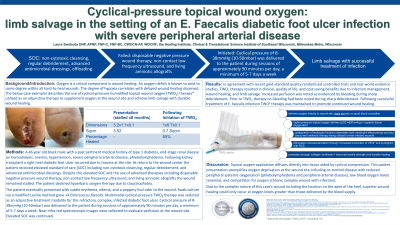Case Series/Study
(CS-140) Cyclical-pressure topical wound oxygen: limb salvage in the setting of an E. Faecalis diabetic foot ulcer infection with severe peripheral arterial disease

Oxygen is a critical component in wound healing. An oxygen deficit is known to exist to some degree within all hard-to-heal wounds. The degree of hypoxia correlates with delayed wound healing observed. The below case exemplar describes the use of cyclical-pressure humidified topical wound oxygen (TWO) therapy utilized as an adjunctive therapy to supplement oxygen at the wound site and achieve limb salvage with durable wound healing.
Methods:
A 46 year old black male with a past pertinent medical history of type 1 diabetes, end-stage renal disease on hemodialysis, anemia, hypertension, severe peripheral arterial disease, phlebolymphedema. Following kidney transplant a right heel diabetic foot ulcer recurred due to trauma at the site. At return to the wound center the patient received elevated standard of care (SOC) including non-cytotoxic cleansing, regular debridement, and advanced antimicrobial dressings. Despite this elevated SOC and the use of advanced therapies including disposable negative pressure wound therapy and living amniotic allografts the wound remained stalled. The patient declined hyperbaric oxygen therapy due to claustrophobia.
The patient eventually presented with subtle erythema, edema, and a peppery foul odor to the wound. Swab culture via a modified Levine method grew +4 Entercoccus faecalis. Multimodal cyclical-pressure TWO therapy was selected as an adjunctive treatment modality for this refractory, complex, infected diabetic foot ulcer. Cyclical pressure of 8-38mmHg (10-50mbar) was delivered to the patient during sessions of approximately 90 minutes per day, a minimum of 5 days a week. Near infra-red spectroscopic images were collected throughout therapy to evaluate perfusion at the wound site. Elevated SOC was continued.
Results:
In agreement with recent gold-standard quality randomized controlled trials and real-world evidence studies, TWO therapy resulted in clinical, quality of life, and cost saving benefits due to infection management, wound healing, and limb salvage.
Discussion:
Direct topical oxygen application diffuses directly into tissue aided by cyclical compression. This patient presentation exemplifies oxygen deprivation at the wound site including co-morbid disease with reduced peripheral systemic oxygenation (phlebolymphedema and peripheral arterial disease), low blood oxygen levels (anemia), and competition for oxygen (chronic complex wound with infection).
Due to the complex nature of this case’s wound including the location on the apex of the heel, superior wound healing could only occur at oxygen levels greater than those delivered by the blood supply.
Trademarked Items: Topical Wound Oxygen, Advanced Oxygen Therapy Inc., Oceanside, CA, USA
References: 1. Swoboda, L. & Held, J. Impaired Wound Healing in Diabetes. Journal of Wound Care. 2022:31(10).
2. Bryant R, Nix D. Acute and Chronic Wounds: Current management concepts. 4th ed. Elsevier. St. Louis, MO. 2015
3. Tracy, Lauren E.; Minasian, Raquel A.; Caterson, E.J. (March 2016). "Extracellular Matrix and Dermal Fibroblast Function in the Healing Wound". Advances in Wound Care. 5 (3): 119–136. doi:10.1089/wound.2014.0561. ISSN 2162-1918.
4. Gupta S, Laskar N, Kadouri DE. Evaluating the Effect of Oxygen Concentrations on Antibiotic Sensitivity, Growth, and Biofilm Formation of Human Pathogens. Microbiol Insights. 2016 Nov 16;9:37-46. doi: 10.4137/MBI.S40767. PMID: 27891050; PMCID: PMC5113855.
5. Castilla DM, Liu ZJ, Velazquez OC. Oxygen: Implications for Wound Healing. Adv Wound Care (New Rochelle). 2012;1(6):225-230. doi:10.1089/wound.2011.0319
6. Sen CK. Wound healing essentials: let there be oxygen . Wound Repair Regen. 2009;17:1–18. doi: 10.1111/j.1524-475X.2008.00436.x.
7. Frykberg RG, Franks PJ, Edmonds M, et al. A Multinational, Multicenter, Randomized, Double-Blinded, Placebo-Controlled Trial to Evaluate the Efficacy of Cyclical Topical Wound Oxygen (TWO2) Therapy in the Treatment of Chronic Diabetic Foot Ulcers: The TWO2 Study. Diabetes Care. 2020;43(3):616-624. doi:10.2337/dc19-0476
8. Niederauer MQ, Michalek JE, Liu Q, Papas KK, Lavery LA, Armstrong DG. Continuous diffusion of oxygen improves diabetic foot ulcer healing when compared with a placebo control: a randomised, double-blind, multicentre study. J Wound Care. 2018;27(Sup9):S30-S45. doi:10.12968/jowc.2018.27.Sup9.S30
9. Shah P, Inturi R, Anne D, et al. Wagner's Classification as a Tool for Treating Diabetic Foot Ulcers: Our Observations at a Suburban Teaching Hospital. Cureus. 2022;14(1):e21501. Published 2022 Jan 22. doi:10.7759/cureus.21501
10. Boulton AJM, Armstrong DG, Löndahl M, et al. New Evidence-Based Therapies for Complex Diabetic Foot Wounds. Arlington (VA): American Diabetes Association; 2022 May. Available from: https://www.ncbi.nlm.nih.gov/books/NBK581559/ doi: 10.2337/db2022-02
11. Gottrup F, Dissemond J, Baines C, et al. Use of Oxygen Therapies in Wound Healing. J Wound Care. 2017;26(Sup5):S1-S43. doi:10.12968/jowc.2017.26.Sup5.S1
12. Oropallo A, Andersen CA. Topical Oxygen. [Updated 2021 Sep 3]. In: StatPearls [Internet]. Treasure Island (FL): StatPearls Publishing; 2022 Jan-. Available from: https://www.ncbi.nlm.nih.gov/books/NBK574579/

.png)